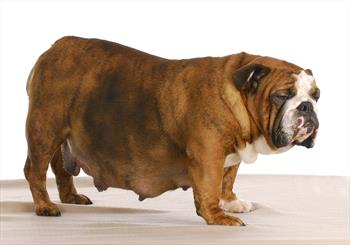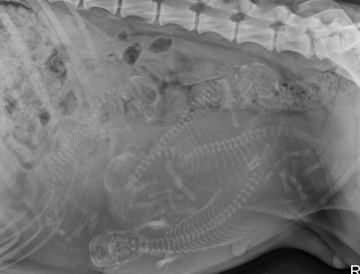Pregnant dog

Are you getting ready for the pitter-patter of little paws? As with humans, you can minimize pregnancy complications with proper care. Having puppies may sound easy, and it may seem like the dog does all the work, but that is not always how it turns out.
So, our first assumption is that the litter is wanted (if not necessarily planned). If the litter is not wanted, consider that there is a terrible canine overpopulation problem, with some shelters euthanizing over 100 dogs DAILY. If your litter is not wanted, please think about spaying the pregnant female or having a medical abortion. Spaying can be performed at any stage in pregnancy; abortion can only be performed during a certain period. Finding homes for puppies is challenging, and there are a limited number of homes to go around, so if there is any question, it may be best to take this opportunity to spay.
Now, having covered that point, we will get on with the subject of caring for a pregnant dog.
The female dog is pregnant for an average of 63 days. Plan accordingly.
Diet
The expectant mother will gradually require increasing amounts of food to nourish her developing litter. A food approved for growth (i.e. a puppy food or a performance diet) will certainly be necessary during the nursing period, and pregnancy may be a good time to transition into this new diet.
About three weeks into the pregnancy, she may experience a little nausea and appetite loss, similar to morning sickness. This should resolve within a week, so if an upset stomach or loss of appetite lasts longer than that or is accompanied by listlessness, something more serious is going on, and you should notify your veterinarian.
Calcium supplementation may be tempting, but is not a good idea. As long as the expectant mother is on a quality diet, supplementation is unnecessary. Furthermore, supplementation can suppress her natural calcium-releasing hormones so that when she really needs extra calcium during nursing, she will not have the proper hormone balance to get it. This can create a very dangerous situation that could easily be avoided by not supplementing with calcium.
At 30 days of pregnancy, bring the female dog to the veterinarian for a wellness check-up and to possibly confirm the pregnancy with a blood test or ultrasound.
Exercise
Regular walking helps the expectant mother keep up her strength, but intensive training, showing, or even obedience school is probably too stressful. Obesity is a dangerous problem for pregnant dogs, and serious blood sugar regulation problems can put the litter at risk. Still, even if the mother-to-be is overweight, pregnancy is not the time for a weight loss program. Your veterinarian will help guide you regarding the optimal nutrition plan for your individual dog.
During the final three weeks of pregnancy, the mother dog should be completely isolated from other dogs at home (see below). This means no walks in public during this stage and no contact with housemate dogs. The reason for this is to prevent the transmission of infectious diseases, especially the canine herpes virus.
Vaccination
A female dog should not be vaccinated during pregnancy; there are normal ingredients in the vaccine that could be harmful to the developing fetus. Ideally, the female should be vaccinated just before breeding. She will be passing on her immunity to her pups in the first milk she produces (milk called colostrum), so we want her antibody levels to be at their peak, yet we want to avoid vaccination during pregnancy.
Parasite Control
If the expectant mother uses a heartworm preventive, she may continue to do so during pregnancy, but be aware that not all products are approved for pregnant and nursing mothers. To see which products have been approved, click here.
Flea control is important during pregnancy, though it is more important after the puppies are born. It is important to use a safe product during pregnancy. To find a product approved for pregnancy and lactation, see our flea product comparison chart.
Roundworms can be transmitted from the pregnant mother to her unborn puppies, and hookworms can be transmitted via nursing. This is a nuisance as you usually end up with both an infected mother and infected puppies, but fortunately, there are several deworming protocols to control these infections. If you have concerns about internal parasites in puppies, speak to your vet about worm control. Daily medication will likely be needed, but worm-free puppies can be born.
Isolate the Mother to Prevent Herpes Infection
Canine herpesvirus infection causes a minor cold in adult dogs but can cause abortion in pregnancy as well as death in newborn puppies. The best way to prevent infection is to isolate the mother completely during the three weeks before delivery and the three weeks after delivery. This means absolutely no contact with other dogs.
Around Day 45
Radiograph of Calcified Puppies In Utero

Puppies seen during Radiograph Photo courtesy Dr. Milan Hess
Just before isolation, it is a good idea for the expectant mother to have a radiograph of her belly to count puppies. Mineralization of the fetal skeleton takes place around day 45 and thereafter can be seen on radiographs. Knowing how many puppies to expect will tell you when she is finished delivering.
Labor and Complications of Delivery
There is always the possibility of a problem with delivery, and you will need to be able to recognize labor when it is occurring, what is normal, and what is a sign you need to see the veterinarian for assistance. See birthing puppies for information on care during labor and nursing.